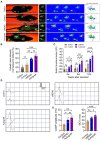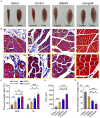Enhancing regeneration and repair of long-distance peripheral nerve defect injuries with continuous microcurrent electrical nerve stimulation
- PMID: 38406586
- PMCID: PMC10885699
- DOI: 10.3389/fnins.2024.1361590
Enhancing regeneration and repair of long-distance peripheral nerve defect injuries with continuous microcurrent electrical nerve stimulation
Abstract
Introduction: Peripheral nerve injuries, especially those involving long-distance deficits, pose significant challenges in clinical repair. This study explores the potential of continuous microcurrent electrical nerve stimulation (cMENS) as an adjunctive strategy to promote regeneration and repair in such cases.
Methods: The study initially optimized cMENS parameters and assessed its impact on Schwann cell activity, neurotrophic factor secretion, and the nerve regeneration microenvironment. Subsequently, a rat sciatic nerve defect-bridge repair model was employed to evaluate the reparative effects of cMENS as an adjuvant treatment. Functional recovery was assessed through gait analysis, motor function tests, and nerve conduction assessments. Additionally, nerve regeneration and denervated muscle atrophy were observed through histological examination.
Results: The study identified a 10-day regimen of 100uA microcurrent stimulation as optimal. Evaluation focused on Schwann cell activity and the microenvironment, revealing the positive impact of cMENS on maintaining denervated Schwann cell proliferation and enhancing neurotrophic factor secretion. In the rat model of sciatic nerve defect-bridge repair, cMENS demonstrated superior effects compared to control groups, promoting motor function recovery, nerve conduction, and sensory and motor neuron regeneration. Histological examinations revealed enhanced maturation of regenerated nerve fibers and reduced denervated muscle atrophy.
Discussion: While cMENS shows promise as an adjuvant treatment for long-distance nerve defects, future research should explore extended stimulation durations and potential synergies with tissue engineering grafts to improve outcomes. This study contributes comprehensive evidence supporting the efficacy of cMENS in enhancing peripheral nerve regeneration.
Keywords: Schwann cell activity; continuous microcurrent electrical nerve stimulation; functional recovery; long-distance nerve defects; peripheral nerve injury; tissue engineering.
Copyright © 2024 Kong, Teng, Liu, Wang, Zhou, Zong, Wan, Qin, Yu, Mi and Wang.
Conflict of interest statement
The authors declare that the research was conducted in the absence of any commercial or financial relationships that could be construed as a potential conflict of interest.
Figures







Similar articles
-
Brief electrical stimulation improves nerve regeneration after delayed repair in Sprague Dawley rats.Exp Neurol. 2015 Jul;269:142-53. doi: 10.1016/j.expneurol.2015.03.022. Epub 2015 Apr 2. Exp Neurol. 2015. PMID: 25842267
-
Repair of peripheral nerve defects by nerve grafts incorporated with extracellular vesicles from skin-derived precursor Schwann cells.Acta Biomater. 2021 Oct 15;134:190-203. doi: 10.1016/j.actbio.2021.07.026. Epub 2021 Jul 18. Acta Biomater. 2021. PMID: 34289422
-
Short-term electrical stimulation to promote nerve repair and functional recovery in a rat model.J Hand Surg Am. 2015 Feb;40(2):314-22. doi: 10.1016/j.jhsa.2014.10.002. Epub 2014 Nov 11. J Hand Surg Am. 2015. PMID: 25459379
-
GDNF to the rescue: GDNF delivery effects on motor neurons and nerves, and muscle re-innervation after peripheral nerve injuries.Neural Regen Res. 2022 Apr;17(4):748-753. doi: 10.4103/1673-5374.322446. Neural Regen Res. 2022. PMID: 34472460 Free PMC article. Review.
-
Delayed peripheral nerve repair: methods, including surgical 'cross-bridging' to promote nerve regeneration.Neural Regen Res. 2015 Oct;10(10):1540-4. doi: 10.4103/1673-5374.167747. Neural Regen Res. 2015. PMID: 26692833 Free PMC article. Review.
Cited by
-
Controlled Magnesium Ion Delivery via Mg-Sputtered Nerve Conduit for Enhancing Peripheral Nerve Regeneration.Adv Healthc Mater. 2025 Aug;14(20):e2500063. doi: 10.1002/adhm.202500063. Epub 2025 Apr 27. Adv Healthc Mater. 2025. PMID: 40289425 Free PMC article.
-
Secondary Ulnar Nerve Reconstruction of High Ulnar Nerve Injuries: A Comparative Study of Sural Grafting and Anterior Interosseous Nerve Transfer.Arch Bone Jt Surg. 2025;13(6):349-358. doi: 10.22038/ABJS.2024.83645.3806. Arch Bone Jt Surg. 2025. PMID: 40641891 Free PMC article.
References
-
- Avendaño-Coy J., López-Muñoz P., Serrano-Muñoz D., Comino-Suárez N., Avendaño-López C., Martin-Espinosa N. (2022). Electrical microcurrent stimulation therapy for wound healing: a meta-analysis of randomized clinical trials. J. Tissue Viability 31, 268–277. doi: 10.1016/j.jtv.2021.12.002, PMID: - DOI - PubMed
LinkOut - more resources
Full Text Sources

